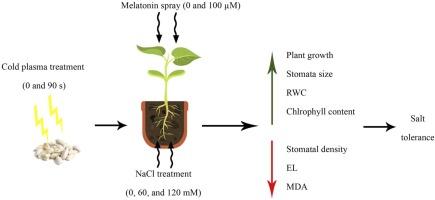Enhancing salt tolerance in Carthamus tinctorius L. using cold plasma and melatonin: Insights from growth, biochemical, and anatomical responses
IF 6.2
1区 农林科学
Q1 AGRICULTURAL ENGINEERING
引用次数: 0
Abstract
Global climate change exposes crops to abiotic and biotic stressors, threatening growth and yield. Salinity is a significant abiotic stress, affecting crop productivity and stability. Although the individual roles of cold plasma (CP) and melatonin (MT) in enhancing stress tolerance have been studied, their synergistic effects under salinity stress remain largely unexplored, particularly in Carthamus tinctorius L. (safflower). This study addressed this gap by evaluating the combined application of CP and MT to improve plant resilience under saline conditions. Seeds were primed with CP (90 s), followed by foliar application of MT (100 µM), to assess their influence on plant resilience in conditions of salt stress (0, 60, and 120 mM NaCl). Salt stress markedly impaired water relations and compromised cell membrane integrity, evidenced by reduced relative water content (RWC) and increased electrolyte leakage (EL). Conversely, plants treated with a combination of CP and MT exhibited enhanced RWC and diminished EL, indicating improved cellular stability. Salinity stress resulted in elevated levels of unsaturated fatty acids, while levels of saturated fatty acids decreased significantly. In addition, salinity increased stomatal density while decreasing stomatal size. Co-application of CP and MT mitigated salt-induced damage at 120 mM NaCl by promoting increases in growth factors (approximately 25 %), stomatal length (19.04 %), and width (16.66 %). Additionally, this combined treatment enhanced chlorophyll a (23.97 %), chlorophyll b (24.8 %), total chlorophyll (25.28 %) content, total phenolics (10.57 %), and flavonoids (21.42 %), while reducing stomatal density (11.29 %) and limiting malondialdehyde accumulation by 22.98 %. These findings highlight, for the first time, the synergistic role of CP and MT in improving salinity tolerance in safflower, filling a critical knowledge gap and suggesting a promising strategy for enhancing crop resilience under saline environments.

利用冷血浆和褪黑素增强红花的耐盐性:来自生长、生化和解剖反应的见解
全球气候变化使作物面临非生物和生物胁迫,威胁到作物生长和产量。盐胁迫是影响作物产量和稳定性的重要非生物胁迫。虽然已经研究了冷等离子体(CP)和褪黑素(MT)在增强胁迫耐受性中的单独作用,但它们在盐胁迫下的协同作用仍未得到充分研究,特别是在红花中。本研究通过评估CP和MT联合施用对提高盐碱条件下植物抗逆性的影响,解决了这一空白。在盐胁迫(0、60和120 mM NaCl)条件下,分别用CP(90 s)和MT(100 µM)对种子进行处理,以评估其对植物抗逆性的影响。盐胁迫显著损害了水分关系和细胞膜完整性,表现为相对含水量(RWC)降低和电解质泄漏(EL)增加。相反,用CP和MT联合处理的植物表现出更高的RWC和更低的EL,表明细胞稳定性得到改善。盐胁迫导致不饱和脂肪酸水平升高,而饱和脂肪酸水平显著降低。盐度增加了气孔密度,减小了气孔大小。在120 mM NaCl处理下,CP和MT的配合施用通过促进生长因子(约25 %)、气孔长度(19.04 %)和宽度(16.66 %)的增加,减轻了盐致损伤。此外,该组合处理提高了叶绿素a(23.97 %)、叶绿素b(24.8 %)、总叶绿素(25.28 %)含量、总酚(10.57 %)和总黄酮(21.42 %)含量,降低了气孔密度(11.29 %),限制了丙二醛积累22.98 %。这些发现首次强调了CP和MT在提高红花耐盐性方面的协同作用,填补了一个关键的知识空白,并为提高盐环境下作物的抗逆性提供了一个有希望的策略。
本文章由计算机程序翻译,如有差异,请以英文原文为准。
求助全文
约1分钟内获得全文
求助全文
来源期刊

Industrial Crops and Products
农林科学-农业工程
CiteScore
9.50
自引率
8.50%
发文量
1518
审稿时长
43 days
期刊介绍:
Industrial Crops and Products is an International Journal publishing academic and industrial research on industrial (defined as non-food/non-feed) crops and products. Papers concern both crop-oriented and bio-based materials from crops-oriented research, and should be of interest to an international audience, hypothesis driven, and where comparisons are made statistics performed.
 求助内容:
求助内容: 应助结果提醒方式:
应助结果提醒方式:


